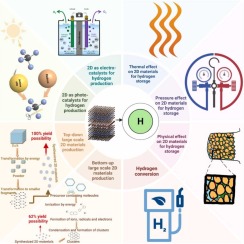
# Graphene Approaches Real-World Implementation: EU Researchers Harness Its Capabilities in Electronics and Sensors
*By Anthony King*
Graphene, celebrated as a “wonder material” in the scientific arena, is steadily moving towards broader use, propelled by substantial research initiatives led by researchers funded by the EU. This ultra-thin substance, composed of a single layer of carbon atoms, has the potential to transform the realms of electronics, sensors, photonics, and more.
Among those at the forefront of transitioning graphene from research labs to industrial applications is Dr. Inge Asselberghs. For the past decade, she has been intensely engaged in leading-edge graphene investigations, particularly through her role at **Imec**, a renowned center for nanoelectronics and digital technologies in Leuven, Belgium. Asselberghs is currently involved in an international endeavor focused on enhancing the production of graphene and other two-dimensional (2D) materials. This work is facilitated by the **EU-funded 2D experimental pilot line (2D-EPL)**.
### A Joint European Project
The 2D-EPL initiative unites **11 universities, research organizations, and corporations** from six European nations. Their collective aim is to develop advanced prototypes that integrate graphene into high-end devices such as electronics, sensors, and photonics systems.
This effort is part of the broader European **Graphene Flagship** initiative—launched in 2013 with a sweeping **€1 billion** funding plan over a decade. The project collaborates with **178 academic and industrial participants** and strives to utilize graphene’s characteristics to achieve progress in various high-tech sectors, encompassing aerospace and energy storage.
### Transitioning From Laboratory to Practical Use: The Potential of Graphene
Graphene is frequently recognized as a potential disruptor in the realms of science and technology. Asselberghs notes that its discovery sparked excitement that soon veered into “hype” due to its remarkable properties.
– **Strength:** Although only a single atom layer thick, graphene boasts exceptional strength—**200 times stronger than steel** by weight.
– **Flexibility:** Its ability to bend and mold without breaking makes it an ideal candidate for flexible electronics and wearable tech.
– **Electrical and Thermal Conductivity:** Graphene excels in conducting both electricity and heat, opening avenues for next-generation transistors, ultrafast data processing, and high-efficiency sensors.
With such versatile attributes, graphene has the capability to transform industries ranging from telecommunications and medical diagnostics to transportation.
### The Path Toward Functional Prototypes
While graphene’s extraordinary qualities make it a desirable option for numerous applications, the challenge lies in developing it into practical, scalable technologies. The 2D-EPL initiative was specifically initiated to translate laboratory advancements into real-world prototyping.
“The primary objective was to determine how to fabricate graphene devices on a wafer scale by adapting existing methods for automated manufacturing,” elaborated Asselberghs. Wafer fabrication—utilizing thin, circular slices of materials in electronics and other sectors—is a conventional technique in semiconductor production.
To speed up the process of incorporating graphene into functional devices, this experimental pilot line stretches across various research and industrial facilities. Notably, Imec has created an **assembly line for wafer processing** that includes graphene and can reach sizes of **200 to 300 mm**—a standard industry size that eases the transition from research to wider industrial application.
### Manufacturing Hurdles: Precision Is Crucial
Graphene’s unmatched thinness presents unique manufacturing challenges. Tiny elements, such as a lone molecule or a speck of dust, can lead to defects and diminish performance.
“Your environment and tools need to be meticulously controlled and clean to prevent any particles from contaminating your device,” stressed Asselberghs.
To address this, the research team designed sophisticated techniques for handling graphene wafers delicately. A vital step in the manufacturing process involves transferring graphene to a silicon substrate, during which it requires protection from a thin polymer layer. Effectively managing such delicate operations in automated environments is essential for scaling up graphene production.
### Beyond Graphene: Investigating the Potential of Other 2D Materials
While graphene remains the most prominent example of a two-dimensional substance, other 2D materials are also under investigation. Some of these materials can serve as **semiconductors** similar to silicon but offer significant advantages, including enhanced electrical performance at much smaller dimensions. These ultrathin semiconductors hold great potential for future chip development, creating new possibilities for compact, high-performance electronics.
Harm Knoops, a Dutch researcher at **Oxford Instruments Plasma Technology**, emphasized Europe’s prominent position in the exploration and development of these materials. “We are in a pretty strong position in Europe with 2D